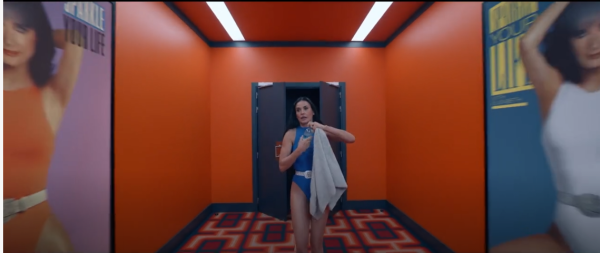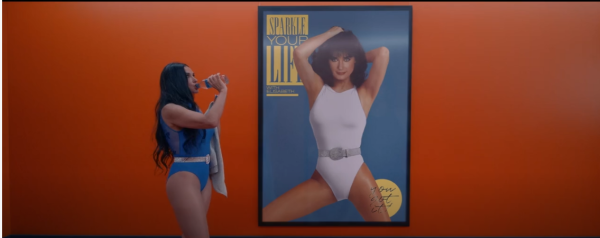*NOTE: This article is the first segment of a continued series.
“The show must go on!” is a term that has dominated the entertainment business since the 19th-century circus era.
It is a term that has snaked its way into Broadway, the music industry, and Hollywood. Anyone with a career in the public eye knows that no matter how dire or concerning the circumstances may be, you must never disappoint your audience.
Coralie Fargeat’s The Substance took the term “The show must go on!” to a new level when it hit theaters September 20 of this year. The Substance has received much recognition for being a gory, body horror-comedy that meets feminism in film in its rawest form.
The film’s protagonist, Elisabeth Sparkle (played by Demi Moore) is an aging Hollywood star who has fallen out of the spotlight since her youth. “Elisabeth Sparkle” is the identity she is desperately trying to hold on to, meanwhile she risks losing “Elisabeth” the more she tries to chase after a persona created to exploit and sexualize her.
The film opens up with an egg yolk on a light blue background as a pair of hands in black gloves inserts a needle with a green liquid into the egg yolk, creating an identical second yolk.
For women, the usage of eggs directly corresponds to the eggs women produce in their ovaries, which decreases over time as women age.
The black hands in gloves injecting the green liquid represents the pressure society projects onto women to stop aging as they get older. Society does this by selling these women products, supplements, programs, etc to look younger.
The egg yolk scene essentially sums the movie up in one sequence, as the green liquid represents the same substance later used in the film.
The film then cuts to the creation of the star, both literally and figuratively, of Elisabeth Sparkle (played by Demi Moore), on the Hollywood Walk of Fame in Los Angeles, California.
Sparkle is then seen posing on her star from a birds-eye view photographed by paparazzi at an event. Then, a sequence of people posing at her decal follows from the same point of view Sparkle was shot in.
Yet as time passes in the film, the popularity of Sparkle’s star decreases and people stop taking pictures and pointing out the star and who it belongs to.
From the clothing worn by the fans taking pictures of Sparkle’s star, we can infer that she must have been popular during the 80s or 90s. So as time passes, the clothing worn by people becomes more modern, technology becomes more present, and Sparkle is left behind in the past.
No one stops to take a picture of her star, instead they just walk over it.
The only time she is remembered is when someone mentions her briefly as they walk over her star and continue on. Sparkle’s star, once new, shiny, and perfect, was now cracked, dirty and discolored; a nod to how women in Hollywood are portrayed once they begin to age.
And yet, amidst the snow, rain, and the amount of people who have walked over Sparkle’s star, there she remains. She’s cracked, but still standing. The end of the sequence follows with a man dropping his lunch on Sparkle’s star, splattering ketchup all over it, which foreshadows the ending scene of the movie.
Sparkle is then shown in a cozy workout studio similar to the ones seen on television for home workouts.
The sign “Sparkle Your Life With Elisabeth” sits on a back window as Sparkle, dressed in a modest leotard and leg warmers, exercises alongside women dressed similarly to her.
The camera pans to show the camera shining on Sparkle in an ominous light, showing how women in Hollywood are always in the spotlight.
But as they get older, that spotlight becomes more critical of them.
Throughout her workout, Sparkle makes it clear that her audience is women, as she continues to say “Hang in there ladies you got it!” to motivate them.
Yet, near the end of her workout, Sparkle says, “Think about those bikini bods, you want to look like a giant jellyfish on the beach?” as a form of motivation as well.
How Sparkle addresses her viewers exercising at home directly correlates to how women in general, but specifically in Hollywood, are always expected to continue to push through and never give up, because women are never allowed to fail.
Women must attain perfection at all times, so Sparkle uses fat-shaming as part of her toxic motivation towards her female audience.
It is always a tragedy when a woman is too lazy to meet society’s unrealistic standards for her. And because of that, she faces scrutiny and consequences for her selfishness.
Sparkle’s workout ends, and as she waves goodbye to her audience, she blows them a kiss with the movie’s now infamous line: “But in the meantime, take care of yourself.”
It’s ironic how Sparkle’s show motivates women to shape and sculpt their bodies to perfection—even when they don’t want to—and also encourages them to “take care of themselves” in the end.
As she exits the film studio, Sparkle heads to a long hallway with posters of her from her early days in her career.
Right before she enters the hallways, however, Sparkle is shown at a run-down area with a graffitied wall and door.
The door foreshadows the same door Elisabeth will enter when she goes to get the substance she uses later in the film.
Also, the second she stops playing the character of Elisabeth Sparkle, she is reminded of how much she is aging, and without her youth and beauty Sparkle really has nothing else going for her in life.
The second she opens the door to a long orange hallway where posters of herself from the peak of her career line the whole hallway, it is brightly lit.The doors that open to the hallway are clean and in good condition.
It’s also worth noting that when Elisabeth exits the studio, she only uses one door, but when she enters the hallway, there are two doors.
The two doors symbolize Elisabeth and her “new self” that she will create later on in the film from the substance, whereas the one door in the run-down part is Elisabeth’s true self, or subconscious, the reality of aging.
The oversaturated hallway is another reminder of how she tries to halt the process of aging by believing she is still the same Elisabeth she was in her youth.
She does this with the color of her outfits in the posters and the color of the leotard she is currently wearing. In one of the posters, her leotard is orange, the same color of the wall, and in the other poster right across from her, the background is blue, the same blue color of the leotard she is currently wearing.
And she can’t let it go, because as she walks down the hallway of past versions of herself staring at her, two women and a man individually tell her, “Happy Birthday!” A seemingly human moment, yet another reminder to Elisabeth that she is old.
For women especially, they dread their birthdays every year, because it is no longer a happy celebration of getting older. Instead, it is a dreadful reminder that they are getting older.
And beyond that, society uses women’s birthdays as a way to remind them they are “expired” or no longer useful, because they are no longer young and beautiful.
The hallway also is a representation of Elisabeth’s brain; it’s silent and empty except for Elisabeth and her past selves.
But, then again, she is never truly alone as she is haunted by the ghost of the woman she used to be.
The ominous hallway is brightly lit to make sure the posters of Elisabeth’s career from over the years are illuminated and to remind her of the star she used to be. Elisabeth then internalizes this by trying to keep that same image, even though she is constantly reminded she is aging.
As she reaches the end of the hallway, Elisabeth heads to the women’s restroom, yet there is an “Out Of Order” sign on the door, another way of society telling Elisabeth she is no longer fit to be a woman because of her age, so she is forced to use the men’s room.
For women, they have a certain window where they are deemed “worthy,” but after their time runs out, they become “out of order.”
Men on the other hand, are given sympathy from society as they age, therefore the men’s bathroom in the movie is not “out of order.”
As Elisabeth goes into the bathroom, she makes sure no one else is in there and heads into a stall.
Seconds later, a man (played by Dennis Quaid) in a floral suit bursts into the bathroom on the phone having an aggressive conversation.
The man is then shown up-close to the camera, as he yells into the phone “I don’t care if [you bring in] every f***ng girl in this f***ng town in the next few weeks! Look, I’ll make it simple: we need her young. We need her hot. We need her now.” As he continues his phone call, he is heard urinating off screen.
The man then says, “How the old b**ch has been able to stick around for this long, that’s the f****ng mystery to me,” he laughs into the phone.
He spews out more sexist remarks like downplaying said woman’s Oscar win and yelling at the person on the phone to, “Find me somebody new. Now!” and leaves the bathroom laughing at the absurdity of the woman’s age.
His last line before he disappears down the hall is “Hey, did you know that a woman’s fertility starts to decrease by the age of 25?” which hints at how Hollywood views women after they turn 25.
In reality, a woman’s fertility doesn’t start to decline until age 32, and then starts to decline rapidly at age 37, according to the American College of Obstetricians and Gynecologists (ACOG).
Yet, Hollywood operates on a different scale, as women are viewed as “expired” after they turn 25.
The man’s inaccurate remark about a woman’s fertility not only shows that men, and Hollywood as a whole, are highly uneducated on women’s bodies, but that they only value how a woman looks.
That kind of mindset has always been present. Taylor Swift, one of the biggest pop stars in history said in her Miss Americana documentary that, “…we do exist in this society where women in entertainment are discarded in an elephant graveyard at 35,” Swift quotes. “Everyone is a shiny new toy for like two years,” she says, and after they stop being “new” and “shiny,” Hollywood discards women and looks for its next shiny new toy.
A great example of that is looking at how other famous men in Hollywood treat women. Hollywood A-Lister Leonardo’s Dicaprio has been known to only date women significantly younger than him, specifically 25 or younger.
Former Patriots head coach Bill Belichick’s new girlfriend is 24 years old, and Al Pacino at 83 years old welcomed a child with his now ex-girlfriend who was 29 at the time.
Watching the man on the screen argue for a new young face to be the next star is like watching Hollywood in real time.
After the man leaves, Elisabeth steps out of the stall.
It’s evident that the woman the man was referring to was Elisabeth, as she looks disgusted at herself in the mirror, as though he spoke personally to her.
The scene goes quiet, and Elisabeth stares into the mirror with a miserable look on her face, studying her insecurities.
A black screen pops up with the word “Elisabeth” in big white bold letters, thus beginning Elisabeth Sparkle’s story.
To Be Continued In The Next Article….



























